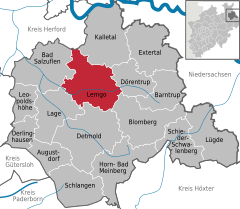Lemgo
| Lemgo | ||
|---|---|---|
|
Aerial view | ||
| ||
 Lemgo | ||
Location of Lemgo within Lippe district 
 | ||
| Coordinates: 52°1′38″N 8°54′42″E / 52.02722°N 8.91167°ECoordinates: 52°1′38″N 8°54′42″E / 52.02722°N 8.91167°E | ||
| Country | Germany | |
| State | North Rhine-Westphalia | |
| Admin. region | Detmold | |
| District | Lippe | |
| Government | ||
| • Mayor | Reiner Austermann (CDU) | |
| Area | ||
| • Total | 100.85 km2 (38.94 sq mi) | |
| Population (2015-12-31)[1] | ||
| • Total | 41,276 | |
| • Density | 410/km2 (1,100/sq mi) | |
| Time zone | CET/CEST (UTC+1/+2) | |
| Postal codes | 32657 | |
| Dialling codes | 05261, 05266 (Brüntorf, partially Matorf-Kirchheide) | |
| Vehicle registration | LIP | |
| Website | www.lemgo.net | |
Lemgo (German pronunciation: [ˈlɛmɡoː]) is a university city in the Lippe district of North Rhine-Westphalia, Germany, with a population of c. 40,800 (2013).
History
It was founded in the 12th century by Bernard II, Lord of Lippe at the crossroad of two merchant routes.
Lemgo was a member of the Hanseatic League, a medieval trading association of free or autonomous cities in several northern European countries such as the Netherlands, Germany and Poland. During the Reformation the city of Lemgo adopted Lutheranism in 1522, whereas otherwise in Lippe, its spread was hampered until 1533 by the opposition of the then Catholic ruling Counts of Lippe.
In 1605 Simon VI, Count of Lippe adopted Calvinism and demanded the conversion of Lemgo's citizens too using his monarchic privilege of cuius regio, eius religio. This led to a dispute with Lemgo. The city defied the edict to convert to Calvinism, leading to the Revolt of Lemgo. This religious dispute was resolved by the Peace of Röhrentrup in 1617, granting Lemgo the right to determine its faith independently. Lippe's Lutheran minority, mostly domiciled in Lemgo, only joined the else Reformed Church of Lippe in 1882, however, retaining its Confession of Augsburg with the Lutheran congregations forming a separate classis within the Lippe church since 1888.
British Army
From 1947 until 1993, Lemgo hosted successive infantry battalions of the British Army, the last one being the Royal Irish Regiment.
The battalions were based in Stornoway Barracks, known to the locals as Spiegelberg Kaserne. The base was previously the location of a Displaced persons camp and before that a Wehrmacht artillery unit.
At the end of WW 2, Canadian Section GHQ, 2nd Echelon, HQ 21 Army Group, occupied Spiegelberg Kaserne. After this headquarters moved to Oldenburg the site was taken over by the British Army.
Research and Education
Lemgo is the location of the OWL University.

Culture
The town supports the Nordwestdeutsche Philharmonie for regular symphony concerts.
International relations
Lemgo is twinned with:
Hörstmar County Primary School in Lemgo has a twin school in Holme on Spalding Moor since 1989.
References
- ↑ "Amtliche Bevölkerungszahlen". Landesbetrieb Information und Technik NRW (in German). 18 July 2016.
